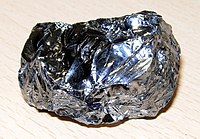
Photo from wikipedia
Accurate modeling of the electrical properties of impurities in semiconductors is essential for the mandatory support of the development of novel semiconductor devices by means of simulations. An appropriate modeling… Click to show full abstract
Accurate modeling of the electrical properties of impurities in semiconductors is essential for the mandatory support of the development of novel semiconductor devices by means of simulations. An appropriate modeling approach to determine the activation rate of dopants in silicon carbide is currently not available, which limits the predictability of process simulations. To remedy this fact, we propose an empirical model for the electrical activation of aluminum and boron impurities in silicon carbide for various annealing temperatures and total doping concentrations. The differences of the two acceptor-type dopants are discussed according to the model predictions and the activation ratios for various processing parameters are presented. The model was implemented into Silvaco’s simulation platform Victory Process and evaluated with respect to published experimental findings.
Journal Title: IEEE Transactions on Electron Devices
Year Published: 2018
Link to full text (if available)
Share on Social Media: Sign Up to like & get
recommendations!